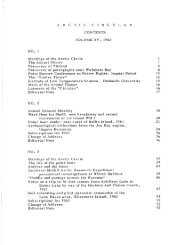Volume 8, 1955 - The Arctic Circle - Home
Volume 8, 1955 - The Arctic Circle - Home
Volume 8, 1955 - The Arctic Circle - Home
- No tags were found...
You also want an ePaper? Increase the reach of your titles
YUMPU automatically turns print PDFs into web optimized ePapers that Google loves.
VOL. Vlll NC. ITHE ,.RCTIC CIRCULn.R7During the melt season, some time was spent on WardHunt Island and on the mainland opposite the island, and plantcollections, geological reconnaissance trips, and glaciologicalstudies were made. During this season, the structure in the iceshelf is exposed, and in spite of difficulties due to the floodingof the troughs extensive trips were made on foot.During the spring and after freeze-up, several journeyswere made along the coast by dog team, and much geological andglaciological data of a reconnaissance nature was obtained. ."Z4-day trip was made to Lands Lokk, and shorter trips were madeacross Disraeli Bay to Cape .~ldrich, to Cape Nares and MarkhamBay, and into McClintock Bay.Collections of rocks, fossils, plants, ins ects, ice, andwater were made in the course of the project and these are nOw beingstudied in various Canadian and U.S. centres. In addition to thesescientific collections, records and relics of several previousexpeditions to Ellesmere Island were recovered.Until recently the geology of northern Ellesmere Islandwas almost unknown. <strong>The</strong> results of the field work carried out in1954 indicate that the geological history of the region is complex.Evidence of several periods of mountain building was found andfossils of Crdovician, Carboniferous, and Permian age werecollected.Soundings by seismic methods and by wire line indicatedepths of about ZJc, to 300 feet along the outer edge of the ice shelfoff Ward Hunt Island, about lZ miles from the mainland. <strong>The</strong> fiordsare greatly over-deepened, and the bottom of Disraeli Bay was notreached with a 1, GOO -foot line.From the coring and seismic surface studies of the shelfice it is apparent that this is a complex deposit of salt-saturatedice, lake ice, and firn ice. reaching a thickness of about l6} feet.'!he salt-saturated 'basement' ice is overlain unconformably bystratified firn ice at the base of which there is an old ablationsurface.<strong>The</strong> origin of the unique ridge and trough topography ofthe shelf ice is not known as yet. <strong>The</strong> distance between ridges andtroughs averages 76::. feet and the relief 7 feet although near landridges Z4 feet in height were observed. Temperatures in a ridgeremained constant at -15 o C during the period of observation. <strong>The</strong>












